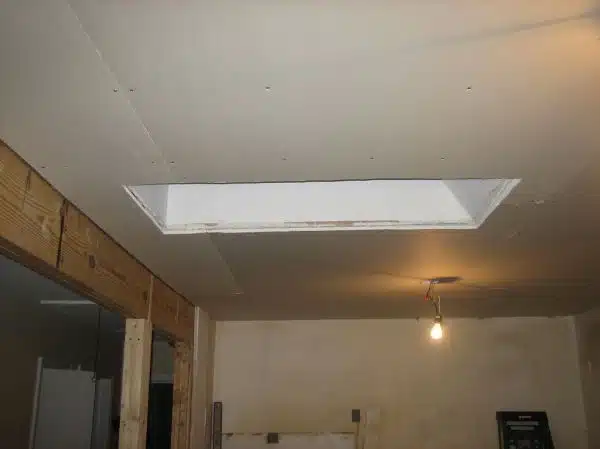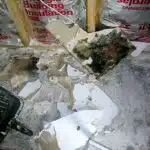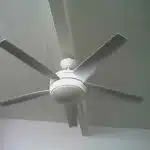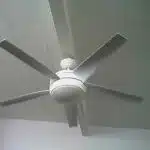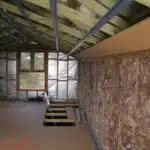The importance of soundproofing in various settings cannot be overstated. Whether it is in a home, office, or studio, excessive noise can have detrimental effects on concentration and productivity. One of the most common areas where soundproofing is necessary is the ceiling. A soundproof ceiling can help reduce noise transmission from the upper floors or outside sources. In this article, we will discuss some effective strategies for soundproofing a ceiling.
Soundproofing a ceiling requires careful planning and execution to achieve optimal results. There are several factors that should be considered when soundproofing a ceiling such as the type of building materials used, level of noise reduction desired, and budget constraints. Additionally, the type of activities that take place in the room below should also be taken into account as this can affect the overall sound quality. By following proper techniques and utilizing effective materials, an acoustic engineer can assist individuals in achieving their desired level of soundproofing for their ceilings. This article will provide some valuable insights and tips on how to effectively soundproof a ceiling to enhance your overall environment while minimizing external disturbances.
Understanding The Importance Of Soundproofing
Soundproofing a ceiling is an important aspect of creating a comfortable and peaceful living or working environment. The importance of soundproofing lies in its ability to reduce unwanted noise, which can cause stress, distraction, and even health issues. Sound travels through walls, floors, and ceilings, making it difficult to control the level of noise that enters a room. By soundproofing the ceiling, you can create a barrier that prevents outside noise from entering the room and reduces the amount of noise that escapes.
There are several common misconceptions about soundproofing that need to be addressed. One misconception is that adding more insulation will automatically make a room soundproof. While insulation can help to some extent, it is not enough to create an effective sound barrier. Another misconception is that only music studios or home theaters require soundproofing. In reality, any room can benefit from soundproofing if there are sources of noise nearby.
As an acoustic engineer, it is my job to assess the level of noise in a space and determine the best course of action for reducing unwanted sounds. Before beginning any soundproofing project, it is important to assess the level of outside noise that enters the room and identify any potential areas where noise may escape. This assessment will help determine what type of materials and techniques should be used for the most effective results.
Assessing The Level Of Noise
Measuring the level of noise is an important step in determining the appropriate noise reduction techniques to use on a ceiling. A sound level meter is commonly used to measure the loudness of noise. This device measures sound pressure levels in decibels (dB). The higher the dB reading, the louder the noise.
To accurately measure noise levels, it is important to take measurements at different times during the day and in different weather conditions. This will ensure that all variations of noise are captured. Once measurements have been taken, it is important to compare them to acceptable noise levels based on local regulations or industry standards.
After measuring the level of noise and comparing it to acceptable standards, it may be necessary to identify problem areas where noise is entering or escaping through the ceiling. These problem areas can include gaps around light fixtures or ventilation ducts, poorly insulated walls or ceilings, and cracks in walls or ceilings. Identifying these problem areas will help determine which specific noise reduction techniques should be used for maximum effectiveness.
- Use earplugs or earmuffs when working in noisy environments.
- Install sound-absorbing materials like acoustic panels or ceiling tiles.
- Consider adding mass-loaded vinyl or other sound barriers between layers of drywall for additional insulation against airborne sound transmission.
With a clear understanding of the level of noise present and identification of potential problem areas, steps can be taken towards effective soundproofing solutions for a ceiling.
Identifying Problem Areas
When it comes to soundproofing a ceiling, identifying problem areas is the first step towards achieving optimal results. It’s important to note that not all ceiling structures are created equal, and some may require more attention than others. In identifying problem areas, one must consider the type of noise they want to mitigate and the unique structure of their ceiling.
Common mistakes in soundproofing a ceiling include overlooking gaps and seams, not addressing vibrations and echoes, and using inadequate materials. Gaps and seams around light fixtures or vents can allow sound waves to travel through them, rendering any other soundproofing efforts useless. Vibrations can also be a major issue as they cause noise to travel through the structure of the building itself. Echoes, on the other hand, occur when sound waves bounce off hard surfaces such as walls or floors. These issues must be addressed before any further steps are taken.
To aid in identifying problem areas and determining which issues need attention, consider using a table like the one below:
| Problem Area | Type of Noise | Severity |
|---|---|---|
| Seams | Outside | High |
| Light fixtures | Inside | Medium |
| Vibration | Inside | High |
| Echoes | Inside | Low |
By filling out this table with information specific to your situation, you can better prioritize which aspects of your ceiling require the most attention. Once these problem areas have been identified, you can move on to choosing the right materials for your project without wasting time or resources on unnecessary steps.
Choosing The Right Materials
When it comes to soundproofing a ceiling, there are various alternatives available in the market. As an acoustic engineer, I recommend choosing materials that can effectively reduce noise transmission from above without breaking the bank. One of the budget-friendly options is mass loaded vinyl (MLV), which is a dense material that can block sound waves. It can be installed between layers of drywall or hung as a barrier using channels and clips.
Another option is acoustic foam panels, which are designed to absorb sound waves rather than block them. These panels are made from open-cell polyurethane foam and are commonly used in recording studios and home theaters. They come in different sizes and shapes, making them easy to install on ceilings with adhesive glue or hanging clips.
Finally, fiberglass insulation is another cost-effective solution for reducing noise transfer from above. This type of insulation is typically made from recycled glass fibers that are woven together to form a mat-like material. It can be easily installed between ceiling joists or over existing drywall using special hangers or staples. However, it’s important to note that this type of insulation may not completely block all sound waves and may need to be combined with other soundproofing materials for optimal results.
Moving on to the next section, we will discuss how to properly install insulation for maximum effectiveness in reducing noise transfer through your ceiling space.
Installing Insulation
After choosing the right materials for your ceiling soundproofing project, it is important to consider the benefits of insulation. Insulating your ceiling can provide a significant reduction in noise transmission between floors. Additionally, it can improve energy efficiency by keeping your home cooler in the summer and warmer in the winter. When selecting insulation materials, there are various options available that offer different levels of soundproofing and thermal insulation.
One popular type of insulation material used for soundproofing ceilings is fiberglass batts. These batts are easy to install and provide effective sound absorption. Mineral wool is another option that provides excellent soundproofing properties as well as fire resistance. If you prefer a more eco-friendly option, consider using cellulose insulation made from recycled paper products. This type of insulation not only provides good soundproofing but also helps reduce carbon emissions.
Installing insulation can be a DIY project or done by a professional acoustic engineer depending on your level of expertise. Before installing, be sure to measure the area where you will be placing the insulation and purchase enough material to cover it adequately. Once installed, make sure there are no gaps or spaces where sound can leak through as this will defeat the purpose of having insulation in place. In the next section, we will discuss how sealing cracks and gaps can further enhance your ceiling’s soundproofing capabilities.
Sealing Cracks And Gaps
Imagine a ceiling as a vast expanse of sky that needs to be sealed to prevent sound from escaping. Just like the sky, it has cracks and gaps that need to be filled. Sealing these cracks and gaps is an essential step in soundproofing your ceiling. It not only helps to stop noise from entering or leaving a room but also adds an extra layer of insulation, making your space energy efficient.
Sealing techniques can vary depending on the type of ceiling you have. If you have a suspended ceiling, the best way to seal it is by using acoustic sealant or caulk. Acoustic sealants are specially designed for soundproofing purposes and are effective in filling even the smallest gaps between tiles. If you have a drywall ceiling, you will need to use drywall tape and joint compound to fill any gaps around light fixtures, vents, or other openings.
Common mistakes people make when sealing their ceilings include not using enough sealant or caulk, failing to clean the surface properly before applying it, or using the wrong type of sealant for their specific needs. Make sure to read the manufacturer’s instructions carefully before starting your project and take note of any ventilation requirements.
Using soundproof drywall is another effective way to soundproof your ceiling and achieve optimal results when combined with sealing techniques. In the next section, we’ll discuss how using soundproof drywall can help reduce noise transmission through your ceiling while providing additional benefits beyond mere sound attenuation.
Using Soundproof Drywall
After sealing cracks and gaps, using soundproof drywall is another effective method of soundproofing a ceiling. Soundproof drywall is specifically designed to reduce noise transmission and can be used in place of regular drywall. It offers several benefits over other materials such as better sound insulation properties, higher density, and improved fire resistance.
One significant advantage of soundproof drywall is its ability to block airborne noise effectively. It has a unique composition that includes layers of gypsum, viscoelastic polymers, and metal channels. These layers work together to absorb and dissipate sound waves, making it an ideal solution for rooms with high levels of ambient noise such as media rooms or recording studios. Additionally, it is thicker than regular drywall, which makes it more effective at blocking noise.
However, the use of soundproof drywall comes at a higher cost compared to other materials like fiberglass insulation or acoustic panels. The installation process can also be more complicated as it requires specific tools and techniques to cut and hang the material correctly. While the initial cost may be higher, the long-term benefits outweigh the drawbacks in terms of reducing overall noise levels in a given space.
In summary, using soundproof drywall provides several benefits over other materials when it comes to reducing noise transmission through ceilings. However, it does come at a higher cost compared to other options like fiberglass insulation or acoustic panels. In the next section, we will discuss adding mass to the ceiling as another effective method for soundproofing a room against unwanted external noise.
Adding Mass To The Ceiling
Adding Mass to the Ceiling: Because who needs a lightweight ceiling anyways?
Ah, the joys of living in an apartment complex where you can hear every footstep, conversation, and even snore from your upstairs neighbor. Luckily, there are cost-effective soundproofing techniques available for those who don’t want to break the bank. One such method is adding mass to your ceiling.
Ceiling soundproofing materials such as Mass Loaded Vinyl (MLV) can be used to add density to the ceiling. MLV is a flexible material that can be easily installed by stapling or nailing it onto the existing drywall. The added weight helps to reduce airborne sounds such as conversations and music from penetrating through the ceiling.
Another option for adding mass to the ceiling is using gypsum board with a higher density than standard drywall. This type of board is known as SoundBreak XP and has a higher STC rating than regular drywall. When installed correctly, it provides an additional layer of sound insulation between floors.
By adding mass to your ceiling, you are increasing its ability to block out unwanted noise from above. As an acoustic engineer, I recommend exploring these cost-effective methods before considering more expensive options such as decoupling or using resilient channels. Speaking of which, let’s dive into how using resilient channels can further improve your soundproofing efforts.
Using Resilient Channels
- Installing resilient channels is an effective option for soundproofing a ceiling as it provides an added layer of acoustic insulation.
- Resilient channels are typically made of galvanized steel and are designed to be suspended from the ceiling joists.
- The channels reduce sound transmission by isolating and decoupling the ceiling drywall from the joists.
- The benefits of using resilient channels include improved sound insulation, greater energy efficiency and better vibration control.
Installing Resilient Channels
When it comes to soundproofing a ceiling, using resilient channels is an effective method to prevent unwanted noise from traveling through the ceiling. The benefits of resilient channels are numerous, including their ability to reduce sound transmission by creating a decoupled surface between the ceiling and the structure above. This decoupling allows for greater vibration isolation, resulting in fewer vibrations and less noise transfer.
To install resilient channels, there are several tips to keep in mind. First, it’s important to ensure that the channels are installed perpendicular to the joists or rafters. This will help prevent any direct contact between the drywall and the framing members, which can cause noise transfer. Additionally, it’s recommended to use screws instead of nails when attaching the channels to the ceiling. Screws provide a more secure attachment and reduce the risk of any movement that could compromise soundproofing efforts.
Overall, installing resilient channels is an effective method for soundproofing a ceiling. By taking advantage of their benefits and following installation tips, you can create a more peaceful environment free from unwanted noise.
Benefits Of Resilient Channels
Resilient channels are an essential component of soundproofing a ceiling. They offer several benefits that make them a popular choice among acoustic engineers, including their ability to reduce noise transmission by creating a decoupled surface between the ceiling and the structure above. This decoupling allows for greater vibration isolation, resulting in fewer vibrations and less noise transfer.
One significant benefit of using resilient channels is their ability to prevent unwanted noise from traveling through the ceiling. By decoupling the drywall from the framing members, they reduce direct contact, which can cause noise transfer. This feature makes resilient channels an effective solution for reducing airborne and impact noises while also improving sound quality within a space.
Furthermore, installing resilient channels is relatively straightforward and requires minimal effort compared to other soundproofing methods. By following installation tips such as ensuring perpendicular installation and using screws instead of nails, one can achieve optimal results without compromising structural integrity. In summary, choosing resilient channels as part of your soundproofing solution provides long-lasting benefits without excessive effort or cost.
Installing Acoustic Panels
Acoustic panels are an effective solution for soundproofing ceilings. These panels are designed to absorb sound waves, reducing the amount of noise that travels through the ceiling. Panel placement is crucial to ensure maximum effectiveness. Panels should be installed in areas where noise is most likely to travel, such as above loud equipment or in rooms where music is played.
There are two main types of acoustic panels: fiberglass and foam. Fiberglass panels are made from tightly packed fibers that trap sound waves and prevent them from bouncing back into the room. Foam panels, on the other hand, have a porous surface that absorbs sound waves and prevents them from reflecting back into the room. Both types of panels have their own unique advantages and disadvantages, so it’s important to choose the right type based on your specific needs.
Before installing acoustic panels, it’s important to consider how many panels you will need and where they should be placed. A general rule of thumb is to cover around 25% to 50% of your ceiling with acoustic panels for optimal soundproofing. Additionally, using a combination of different panel types can help improve overall performance. By strategically placing the right number and type of acoustic panels in your ceiling, you can significantly reduce unwanted noise and create a more peaceful environment.
In order to enhance your soundproofing efforts even further, it may be necessary to also consider soundproofing a drop ceiling. This involves adding insulation between the tiles and joists of your drop ceiling, as well as using resilient channels or clips to suspend the tiles away from the structure above. This approach can help reduce both airborne and impact noise by creating an additional barrier between your living space and any sources of unwanted noise above it.
Soundproofing A Drop Ceiling
As we explored in the previous section, installing acoustic panels can greatly improve sound quality in a room. However, when it comes to soundproofing a ceiling, drop ceiling alternatives and other methods may be necessary.
Drop ceilings are a popular choice for soundproofing as they allow access to the space above the ceiling where additional insulation and materials can be added. These types of ceilings consist of tiles suspended on a metal grid system, creating an air gap between the original ceiling and the drop ceiling. This gap can then be filled with insulation material to reduce sound transmission. Other options for soundproofing a ceiling include adding mass-loaded vinyl or using resilient channels.
When considering drop ceiling alternatives or other methods for soundproofing, it’s important to factor in cost. The price of materials and installation will vary depending on factors such as the size of the room and desired level of sound isolation. It’s also important to keep in mind that while these methods can greatly reduce sound transmission, they may not completely eliminate all noise from entering or exiting a room.
Moving forward, we will explore another common type of ceiling – concrete ceilings – and discuss effective ways to soundproof them for optimal acoustic performance.
Soundproofing A Concrete Ceiling
A concrete ceiling can be a source of noise pollution, especially if you live in an apartment building or near a busy street. Soundproofing your concrete ceiling can help reduce the amount of noise that enters your home. There are two options for soundproofing your concrete ceiling: DIY or hiring a professional.
If you decide to do it yourself, there are several steps you can take. The first step is to identify the source of the noise and determine which type of soundproofing material is best suited for your needs. Once you have chosen the right materials, you will need to install them properly. This can be a time-consuming and difficult process, but it is possible to achieve good results with some effort.
On the other hand, hiring a professional acoustic engineer may be a better option if you want guaranteed results. A professional will assess your situation and provide expert advice on which materials and techniques are most effective for your specific needs. They will also have access to specialized equipment and tools that are not available to the average homeowner. While this option may be more expensive than doing it yourself, it could save you time and money in the long run by ensuring that your soundproofing efforts are successful.
To ensure that your concrete ceiling is properly soundproofed, consider hiring a professional acoustic engineer who specializes in soundproofing solutions. An experienced professional will be able to assess your situation and recommend the best course of action based on their expertise and knowledge of industry standards. Additionally, they will have access to cutting-edge technology and equipment that can deliver superior results compared to DIY methods. With their help, you can enjoy a quieter home environment without having to worry about unwanted noise pollution from outside sources.
Hiring A Professional Acoustic Engineer
After exploring methods for soundproofing a concrete ceiling, it may become apparent that some techniques require more investment than others. Despite this, the benefits of a fully soundproofed space can make the cost effectiveness of such measures worth considering. Hiring a professional acoustic engineer may be one such measure to consider.
Acoustic engineers are trained professionals who specialize in creating optimal sound environments for various spaces. They have the knowledge and expertise to assess a room’s acoustics and create customized solutions based on the specific needs of each client. While hiring an acoustic engineer may seem like an additional expense, their involvement can help prevent costly mistakes and ensure that the desired level of soundproofing is achieved.
Here are five potential benefits of working with an acoustic engineer for your soundproofing needs:
- Customized solutions tailored to your specific needs
- Professional analysis of your space’s acoustics
- Access to specialized equipment and materials
- Expert installation and guidance throughout the process
- Confidence in achieving desired results
By enlisting the help of an acoustic engineer, you can feel confident that your investment in soundproofing will be cost effective in the long run. The expertise and resources they bring to the table can help ensure that your space will meet your expectations in terms of noise reduction. In the next section, we’ll delve into how you can test the effectiveness of your newly soundproofed space.
Testing The Soundproofing Effectiveness
Measuring the effectiveness of soundproofing measures is an essential step in ensuring that your efforts have been successful. One common method of measurement is through the use of a decibel meter, which can measure the level of sound inside and outside the room. A before-and-after comparison will give you an idea of how much noise reduction has been achieved.
It’s important to note that there are different types of soundproofing alternatives available, and each one may have varying degrees of effectiveness depending on your specific needs. For example, adding mass-loaded vinyl or acoustic panels to the ceiling can help reduce noise levels, but they might not completely eliminate all sounds from entering or leaving the room. It’s crucial to choose a solution that fits your needs and budget while also considering factors such as ease of installation and maintenance.
In summary, measuring effectiveness is critical when it comes to soundproofing a ceiling. There are different options available for soundproofing, and it’s important to choose one that meets your needs. When deciding on a solution, consider factors such as cost, ease of installation and maintenance, as well as its effectiveness in reducing noise levels. With these considerations in mind, you can make an informed decision about how best to achieve optimal soundproofing results for your space. Moving on to maintaining your soundproof ceiling…
Maintaining Your Soundproof Ceiling
Maintenance Tips for Your Soundproof Ceiling
Congratulations on successfully installing a soundproof ceiling! The next step is to maintain it properly to ensure that it stays in good condition and performs effectively. Here are some maintenance tips that you can follow:
Firstly, regularly inspect your ceiling for any signs of damage or wear and tear. Check for cracks, leaks, or holes in the ceiling panels, as these can compromise the soundproofing capabilities of your ceiling. If you spot any issues, be sure to address them promptly to prevent further damage.
Secondly, keep your ceiling clean and free from dust and debris. Use a soft-bristled brush or vacuum cleaner with a soft attachment to remove any accumulated dust or dirt on the surface of your ceiling. Avoid using harsh chemicals or abrasive materials that can scratch or damage the panels.
Finally, avoid making common mistakes that can compromise the effectiveness of your soundproofing efforts. For example, don’t drill holes into the ceiling panels without first consulting an expert, as this can create weak spots in the structure that allow sound to leak through. Additionally, be cautious when hanging heavy objects from your ceiling, as this can put undue stress on the panels and cause them to deform over time.
By following these maintenance tips and avoiding common mistakes, you can ensure that your soundproof ceiling remains effective and performs well for years to come.
Conclusion
Soundproofing a ceiling is essential for those who wish to create a peaceful and quiet environment, free from unwanted noise. To achieve this goal, it is necessary to assess the level of noise, identify problem areas, choose the right materials and install insulation. Concrete ceilings require extra attention and may need the assistance of a professional acoustic engineer.
Hiring an experienced acoustic engineer can help ensure that your soundproofing efforts are effective and efficient. They can advise on the best materials for your specific needs, as well as provide expert installation services. Testing the effectiveness of your soundproof ceiling is important to ensure that it has achieved its desired effect.
In conclusion, creating a soundproof ceiling requires careful planning and execution. By understanding the importance of soundproofing, assessing the level of noise, identifying problem areas, choosing the right materials, installing insulation and testing the effectiveness of your soundproofing efforts, you can create a peaceful and serene environment in which to live or work. Hiring an experienced acoustic engineer can also help ensure that your project is successful in achieving its goals. Maintaining your soundproofed ceiling will keep it in good condition for many years to come.
Image Credits

